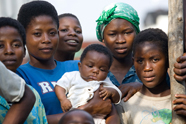
In just a few weeks, a baby who will be the 7 billionth inhabitant of planet Earth will be born. In view of this milestone, DESA News interviewed Hania Zlotnik, who heads UN DESA’s Population Division, the unit in charge of preparing the official UN population projections that provide the basis for estimating the day when the world population will cross the 7 billion mark.
The United Nations Population Fund (UNFPA) is commemorating this event by leading the “7 Billion Actions” campaign which will culminate on “7 Billion Day” on 31 October. The campaign spotlights both the challenges and opportunities that the large current population of the world entails. The latter revolve around the 1.7 billion young people aged 15 to 29, whose energy and fresh ideas will contribute to shape the world’s future and the increasingly well trained population of women and girls whose opportunities for learning, working and having a say in their countries’ future are on the rise.
Behind the scenes, producing all the data on which the campaign relies, is the team of six demographers working for the Population Estimates and Projections Section of the Population Division. On 3 May, the Division released the 2010 Revision of World Population Prospects, whose medium variant projects a world population of 9 billion in 2043 and 10 billion in 2083.
DESA News met with Hania Zlotnik at the Population Division, which she has led as Director since 2005 and where she has worked for close to 30 years in demographic research. Our discussion focused mainly on the different challenges posed by an ever growing population. “There is still considerable uncertainty about what the future population of the world will be. Although the speed of population growth has declined markedly since it peaked in the late 1960s, it is still too high, suggesting that it is still possible for the population to keep on adding a billion every 12 to 13 years as it has done over the past 25 years unless fertility decline accelerates in the countries where fertility remains high,” she said.
Ms. Zlotnik explains that the decline in mortality during the 20th century is one of the reasons behind the rapid population growth experienced since 1950. At the same time, she also highlights that fertility started declining in the 1970s and that population growth has been dropping, so that population today is lower than it might have been.
Fertility needs to decline further
Given that the world now has a large number of young people, Hania Zlotnik notes that it is very important for the future of humanity that the young people of today have on average fewer children than their parents did, especially because they expect to live much longer than their parents.
According to Ms. Zlotnik, the world today has three groups of countries. Those having low fertility, where people are having so few children that the population is expected to decline in the future, account for 42 per cent of the world population. They include nearly all countries in Europe but also several in the developing world, such as China, Brazil, Thailand and Tunisia.
Then there are the countries where fertility is such that each generation gives rise to another generation that is at most half as big as the first. They account for 40 per cent of the world population and belong to the group of intermediate-fertility countries. The remaining 18 per cent of the world population lives in high- fertility countries, where successive generations are increasing by well over 50 per cent. Most least developed countries have high fertility.
“The potential for continued population growth is particularly marked in the high-fertility countries. Because the low-fertility countries as a group are projected to see their populations decline at some point in the future, all the population growth expected by 2100 is generated by the high and the intermediate-fertility countries”, adds Hania Zlotnik.
So far, fertility has declined markedly in over 80 per cent of the world population. The question is whether it will do so also in the 18 per cent that is lagging behind and if the intermediate-fertility countries will emulate those populations that have today fewer than two children per woman. The medium variant of the UN population projections assumes that in both cases fertility will drop to levels close to those of low-fertility countries by the second half of this century, which result in a world population of 10.1 billion in 2100.
Close ties to the MDGs
To be able to achieve the projected reductions of fertility, three courses of action need to be pursued with urgency. Women have to have easy access to effective contraceptive methods so that they are able to have children when they want and to have the number of children that they and their partners want. Because education empowers people to make decisions and acquire the means to realize them, the drive to ensure universal education is also beneficial in this regard. Lastly, it is crucial to empower women in other aspects of life so that they have opportunities and options beyond marriage and childbearing.
“That is why population outcomes are so intimately tied to success in achieving the MDGs, which include the reduction of the unmet need for contraception, the achievement of universal education, particularly among girls, and the empowerment of women” says Ms. Zlotnik. In addition, several of the health-related MDGs are easier to attain if women have fewer children and extend the intervals between pregnancies.
“We know that if women have children at intervals of three years or more, both women and children fare better. There’s clear evidence that both child and maternal mortality are higher the closer the pregnancies, because women’s bodies do not have time to recover from one pregnancy before they have another and they cannot provide enough care to a small child when a new baby arrives.” Another relevant measure is postponing marriage. “We know that in the areas where adolescent fertility is very high, it is because marriage occurs early.”
Hania Zlotnik points out that the changes involved in reducing fertility are good in themselves because they improve the lives of women, their children and their families. But they are also important in the efforts to reduce population growth.
Importance of supportive governments
Ms. Zlotnik also stresses the importance of supportive governments who are ultimately responsible for strengthening health care systems, making contraceptives available and taking the lead in changing norms about childbearing and child rearing. She highlights the case of Bangladesh, one of the least developed countries, where despite the many challenges it faces, fertility has been reduced by two-thirds since the 1960s.
“The Government of Bangladesh established a core group of women to visit women at home, especially when they had just delivered their babies, to talk with them about how to take care of their babies and also about the spacing between their children. These visiting women were trained to offer information and advice about contraceptive methods and to distribute contraceptive supplies. That is how they achieved important increases in contraceptive use among women who were largely illiterate and with low levels of empowerment.”
Hania Zlotnik noted that the number of children under 15 in the least developed countries would have been 22 per cent lower today if they had achieved the same fertility reduction as Bangladesh. That is, by reducing fertility in the past, the least developed countries as a whole would be in a better position today to invest more per child and improve the human capital of future generations.
Ecological constraints on the rise
It is the poorest populations that lack access to services and to the support networks that would otherwise enable them to act in a way consistent with the decisions they would like to make about their lives. Ms. Zlotnik adds that there are other challenges exacerbated by population growth, “especially for the poor who are bearing the brunt of the ecological constraints that the world system is beginning to experience.”
The ecological limitations are not necessarily linked directly to population, she clarifies, but they have become more evident as a result of the recent global crises, which have resulted in increasing food prices and food scarcity in some countries. These developments further underscore the need to reduce fertility rates, so as to increase the degrees of freedom that low-income countries have to assist those in need.
As Hania Zlotnik points out, “if their populations were to grow more slowly, they would find it easier to cope with existing constraints.” Despite these challenges, Ms. Zlotnik also highlights the positive aspects of welcoming the seven billionth inhabitant of planet Earth. “We can celebrate that even as the population reaches seven billion, more people are living better today than ever before in human history. That is a success story.”
For more information:
2010 Revision of the World Population Prospects: http://esa.un.org/unpd/wpp/index.htm
UN DESA’s Population Division: http://www.un.org/esa/population/unpop.htm
World Fertility Policies 2011: http://www.un.org/esa/population/publications/worldfertilitypolicies2011/wfpolicies2011.html
7 Billion Actions Campaign: http://7billionactions.org/


